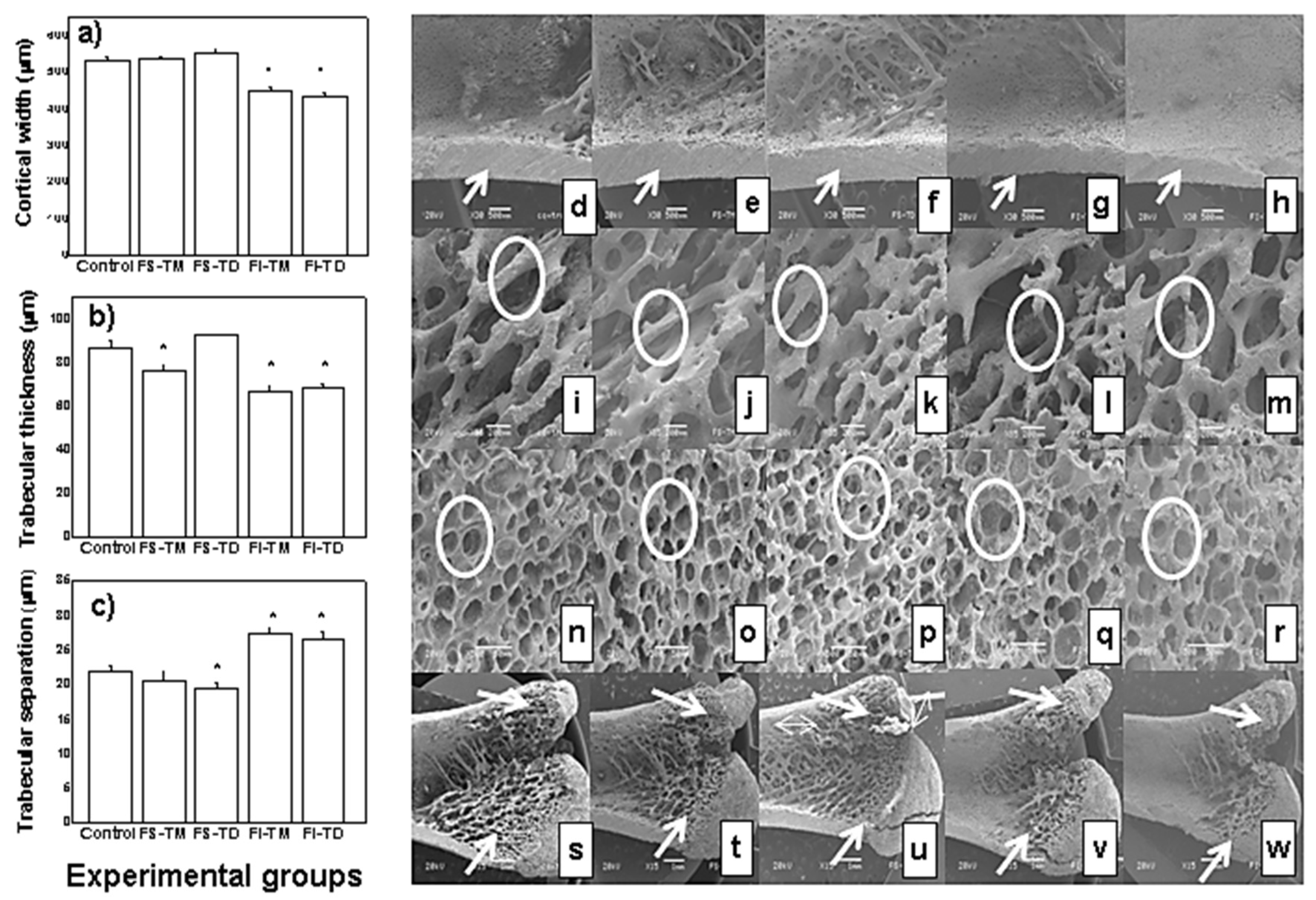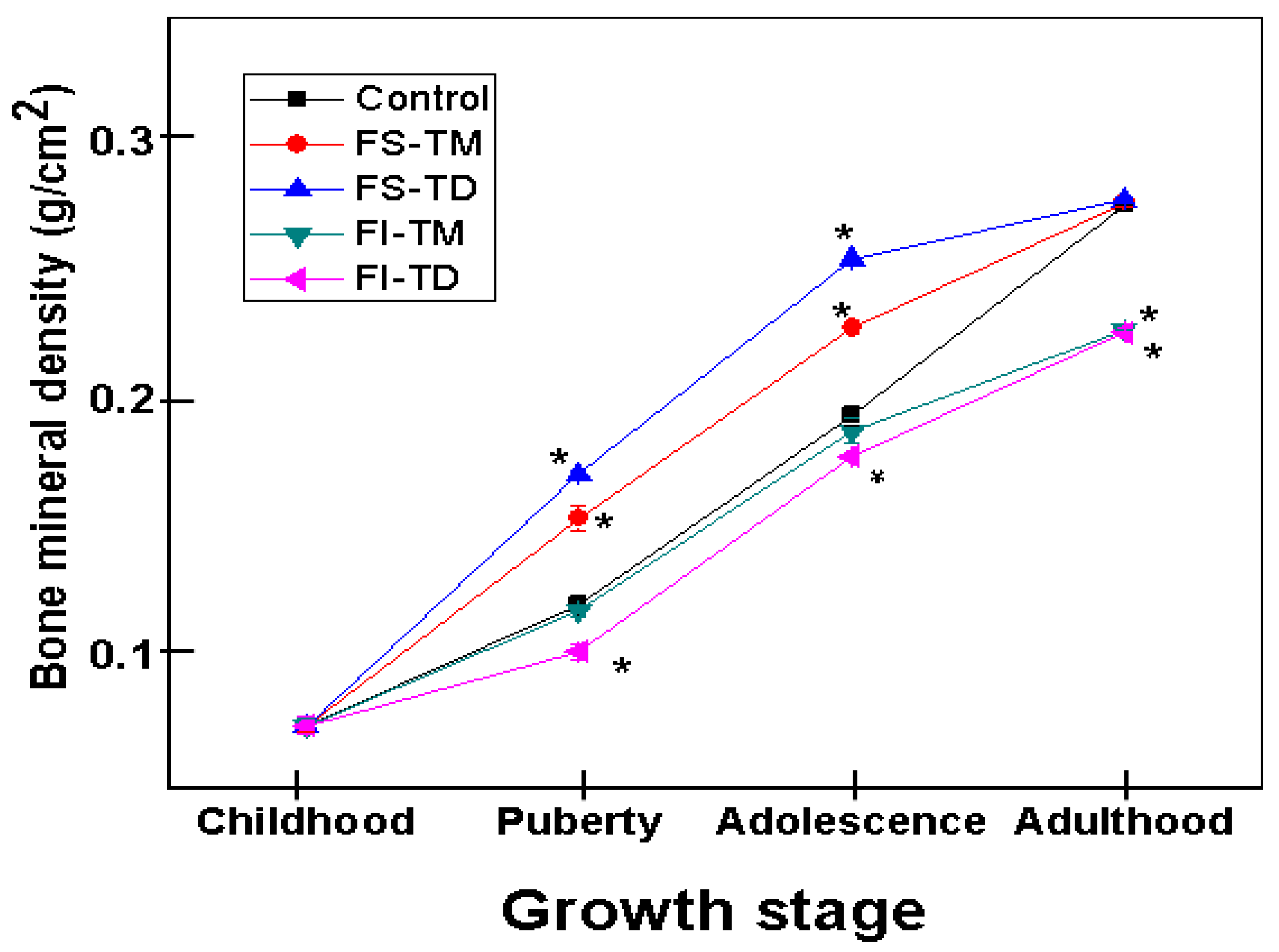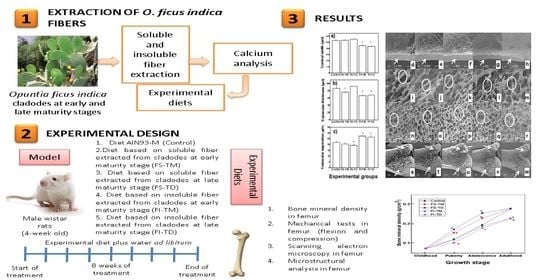Calcium Bioavailability in the Soluble and Insoluble Fibers Extracted from Opuntia ficus indica at Different Maturity Stages in Growing Rats
Abstract
1. Introduction
2. Materials and Methods
2.1. Vegetal Material
2.2. Determination of Mineral (Calcium, Phosphorus, Magnesium, and Potassium) Contents in the Soluble and Insoluble Dietary Fiber of O. ficus indica Cladodes
2.3. Experimental Diets
2.4. Experimental Design
2.5. Assessment of Femoral Dimensions and Weight
2.6. Analysis of Biomechanical Properties of Rat Femurs
2.7. Determination of Mineral Content in Rat Femoral Bones
2.8. Analysis of Microstructural Properties of Rat Femoral Bones
2.9. Assessment of Bone Mineral Density
2.10. X-ray Diffraction Analysis of Femoral Bones
2.11. Statistical Analyses
3. Results
3.1. Mineral Content in the Soluble and Insoluble Fiber Extracted from O. ficus indica
3.2. Body Weight Gain, Food Intake, and Food Efficiency in Rats Fed Control and Experimental Diets
3.3. Assessment of Dimensions and Biomechanical Properties of the Femurs of the Rats Fed the Soluble and Insoluble Dietary Fiber of O. ficus indica as a Calcium Source
3.4. Assessment of Bone Mineral Contents
3.5. Assessment of Microstructural Properties of Femurs of Rats Fed the Soluble and Insoluble Dietary Fiber of O. ficus indica as the Only Calcium Source by SEM
3.6. Assessment of Bone Mineral Density of Femoral Bones
3.7. Assessment of Crystallographic Analysis of Femoral Bone
4. Discussion
5. Conclusions
Author Contributions
Funding
Acknowledgments
Conflicts of Interest
References
- Greer, F.R.; Krebs, N.F. Optimizing Bone Health and Calcium Intakes of Infants, Children, and Adolescents. Pediatrics 2006, 117, 578–585. [Google Scholar] [CrossRef] [PubMed]
- Mesias, M.; Seiquer, I.; Navarro, M.P. Calcium Nutrition in Adolescence. Crit. Rev. Food Sci. Nutr. 2011, 51, 195–209. [Google Scholar] [CrossRef] [PubMed]
- Pan, K.; Zhang, C.; Yao, X.; Zhu, Z. Association between dietary calcium intake and BMD in children and adolescents. Endocr. Connect. 2020, 9, 194–200. [Google Scholar] [CrossRef] [PubMed]
- Weaver, C.M.; Gordon, C.M.; Janz, K.F.; Kalkwarf, H.J.; Lappe, J.M.; Lewis, R.; O’Karma, M.; Wallace, T.C.; Zemel, B.S. The National Osteoporosis Foundation’s position statement on peak bone mass development and lifestyle factors: A systematic review and implementation recommendations. Osteoporos. Int. 2016, 27, 1281–1386. [Google Scholar] [CrossRef] [PubMed]
- Dietary Reference Intakes. Recommendations to Prevent and Control Iron Deficiency in the United States; Morbid Mortal Nuk MMWR 1998; National Academy Press: Washington, DC, USA, 2001. [Google Scholar]
- Bourges, H.; Casanueva, E.; Rosado, J. Recomendaciones de Ingestión de Nutrimentos Para la Población Mexicana; Tomo II; Editorial Médica Panamericana: Mexico City, Mexico, 2009. [Google Scholar]
- Robertfroid, M.B. Inulyn-type fructans: Functional food ingredients. J. Nutr. 2007, 137, 2493S–2502S. [Google Scholar] [CrossRef]
- Scholz-Ahrens, K.E.; Adolphi, B.; Rochat, F.; Barclay, D.F.; Vrese, M.; Açil, Y.; Schrezenmeir, J. Effects of probiotics, prebiotics, and synbiotics on mineral metabolism in ovariectomized rats—Impact of bacterial mass, intestinal absorptive area and reduction of bone turn-over. NFS J. 2016, 3, 41–50. [Google Scholar] [CrossRef]
- Rodríguez-García, M.E.; De Lira, C.; Hernández-Becerra, E.; Cornejo-Villegas, M.A.; Palacios-Fonseca, A.J.; Rojas-Molina, I.; Reynoso, R.; Quintero, L.C.; Del-Real, A.; Zepeda, T.A.; et al. Physicochemical Characterization of Nopal Pads (Opuntia ficus indica) and Dry Vacuum Nopal Powders as a Function of the Maturation. Plant Foods Hum. Nutr. 2007, 62, 107–112. [Google Scholar] [CrossRef]
- McGarvie, D.; Parolis, H. Methylation analysis of the mucilage of Opuntia ficus-indica. Carbohydr. Res. 1981, 88, 305–314. [Google Scholar] [CrossRef]
- Hernández-Urbiola, M.; Contreras-Padilla, M.; Pérez-Torrero, E.; Hernández-Quevedo, G.; Rojas-Molina, J.; Cortés, M.; Rodríguez-García, M. Study of Nutritional Composition of Nopal (Opuntia ficus indica cv. Redonda) at Different Maturity Stages. Open Nutr. J. 2010, 4, 11–16. [Google Scholar] [CrossRef]
- Rojas-Molina, I.; Gutiérrez-Cortez, E.; Bah, M.; Rojas-Molina, A.; Ibarra-Alvarado, C.; Rivera-Muñoz, E.; Del Real, A.; Aguilera-Barreiro, M.D.L.A. Characterization of Calcium Compounds inOpuntia ficus indicaas a Source of Calcium for Human Diet. J. Chem. 2015, 2015, 710328. [Google Scholar] [CrossRef]
- Astley, S.; Finglas, P. Nutrition and Health. In Reference Module in Food Science; Digital Science & Research Solutions, Inc.: London, UK, 2016. [Google Scholar] [CrossRef]
- Hernández-Becerra, E.; Gutiérrez-Cortez, E.; Del Real, A.; Rojas-Molina, A.; Rodríguez-García, M.; Rubio, E.; Quintero-García, M.; Rojas-Molina, I. Bone mineral density, mechanical, microstructural properties and mineral content of the femur in growing rats fed with Opuntia ficus indica as calcium source in diet. Nutrients 2017, 9, 108. [Google Scholar] [CrossRef] [PubMed]
- Quintero-García, M.; Gutiérrez-Cortez, E.; Rojas-Molina, A.; Mendoza-Ávila, M.; López, M.G.; Rubio-Rosas, E.; Jiménez-Mendoza, D.; Rojas-Molina, I. Calcium Bioavailability of Opuntia ficus-indica Cladodes in an Ovariectomized Rat Model of Postmenopausal Bone Loss. Nutrients 2020, 12, 1431. [Google Scholar] [CrossRef]
- AOAC International. Official Methods of Analysis of the Association of Official Analytical Chemists, 17th ed.; AOAC International: Gaithersburg, MD, USA, 2000. [Google Scholar]
- Hernandez-Becerra, E.; Mendoza-Avila, M.; Jiménez-Mendoza, D.; Gutierrez-Cortez, E.; Rodríguez-García, M.E.; Rojas-Molina, I. Effect of Nopal (Opuntia ficus indica) Consumption at Different Maturity Stages as an Only Calcium Source on Bone Mineral Metabolism in Growing Rats. Biol. Trace Elem. Res. 2020, 194, 168–176. [Google Scholar] [CrossRef] [PubMed]
- Reeves, P.G.; Nielsen, F.H.; Fahey, J.G.C. AIN-93 Purified Diets for Laboratory Rodents: Final Report of the American Institute of Nutrition Ad Hoc Writing Committee on the Reformulation of the AIN-76A Rodent Diet. J. Nutr. 1993, 123, 1939–1951. [Google Scholar] [CrossRef]
- Lobo, A.R.; Colli, C.; Filisetti, T.M. Fructooligosaccharides improve bone mass and biomechanical properties in rats. Nutr. Res. 2006, 26, 413–420. [Google Scholar] [CrossRef]
- Hernández-Becerra, E.; Jímenez-Mendoza, D.; Mutis-Gonzalez, N.; Pineda-Gomez, P.; Rojas-Molina, I.; Rodríguez-García, M.E. Calcium Deficiency in Diet Decreases the Magnesium Content in Bone and Affects Femur Physicochemical Properties in Growing Rats. Biol. Trace Elem. Res. 2020, 197, 224–232. [Google Scholar] [CrossRef] [PubMed]
- Londoño-Restrepo, S.M.; Jerónimo-Cruz, R.; Millán-Malo, B.M.; Rivera-Muñoz, E.M.; Rodríguez-García, M.E. Effect of the nano cristal size on the X-ray diffraction patterns of biogenic hydroxyapatite from human, bovine, and porcine bones. Sci. Rep. 2019, 9, 5915. [Google Scholar] [CrossRef]
- Feugang, J.M.; Konarski, P.; Zou, D.; Stintzing, F.; Zou, C. Nutritional and medicinal use of Cactus pear (Opuntia spp.) cladodes and fruits. Front Biosci. 2006, 11, 2574–2589. [Google Scholar] [CrossRef] [PubMed]
- Contreras-Padilla, M.; Rivera-Muñoz, E.; Gutiérrez-Cortez, E.; Del López, A.R.; Rodríguez-García, M.E. Characterization of crystalline structures in Opuntia ficus-indica. J. Biol. Phys. 2014, 41, 99–112. [Google Scholar] [CrossRef]
- Weaver, C.M.; Martin, B.R.; Story, J.A.; Hutchinson, I.; Sanders, L. Novel fibers increase bone calcum content and strength beyond efficiency of large intestine fermentation. J. Agric. Food Chem. 2010, 58, 8952–8957. [Google Scholar] [CrossRef]
- Lobo, A.R.; Cocato, M.L.; Jorgetti, V.; De Sá, L.R.; Nakano, E.Y.; Colli, C. Changes in bone mass, biomechanical properties, and microarchitecture of calcium- and iron-deficient rats fed diets supplemented with inulin-type fructans. Nutr. Res. 2009, 29, 873–881. [Google Scholar] [CrossRef] [PubMed]
- Park, C.; Weaver, C. Calcium and bone health: Influence of prebiotic. Funct. Food Rev. 2011, 3, 62–72. [Google Scholar]
- Kruger, M.C.; Brown, K.E.; Collett, G.; Layton, L.; Schollum, L.M. The Effect of Fructooligosaccharides with Various Degrees of Polymerization on Calcium Bioavailability in the Growing Rat. Exp. Biol. Med. 2003, 228, 683–688. [Google Scholar] [CrossRef]
- Lobo, A.R.; Colli, C.; Alvares, E.P.; Filisetti, T.M.C. Effects of fructans containing yacon (Smallanthus sonchifolius Poepp & Endl.) flour on the morphometry of cecal mucosa, calcium and magnesium balance and bone calcium retention in growing rats. Br. J. Nutr. 2007, 97, 776–785. [Google Scholar] [PubMed]
- Scholz-Ahrens, K.E.; Ade, P.; Marten, B.; Weber, P.; Timm, W.; Aςil, Y.; Gluer, C.-C.; Schrezenmeir, J. Prebiotics, Probiotics, and Synbiotics Affect Mineral Absorption, Bone Mineral Content, and Bone Structure. J. Nutr. 2007, 137, 838S–846S. [Google Scholar] [CrossRef]
- Kyriazis, V.; Tzaphlidou, M. Skeletal Calcium/Phosphorus Ratio Measuring Techniques and Results. I. Microscopy and Microtomography. Sci. World J. 2004, 4, 1027–1034. [Google Scholar] [CrossRef]
- Bryk, G.; Coronel, M.Z.; Pellegrini, G. Effect of a combination GOS/FOS® prebiotic mixture and interaction with calcium intake on mineral absorption and bone parametrs in growing rats. Eur. J. Nutr. 2015, 54, 913–923. [Google Scholar] [CrossRef]
- Demigné, C.; Jacobs, H.; Moundras, C.; Davicco, M.-J.; Horcajada, M.-N.; Bernalier, A.; Coxam, V. Comparison of native or reformulated chicory fructans, or non-purified chicory, on rat cecal fermentation and mineral metabolism. Eur. J. Nutr. 2008, 47, 366–374. [Google Scholar] [CrossRef]
- Palacios, C. The Role of Nutrients in Bone Health, from A to Z. Crit. Rev. Food Sci. Nutr. 2006, 46, 621–628. [Google Scholar] [CrossRef]
- Giraldo-Betancur, A.L.; Espinosa-Arbelaez, D.F.; Del Real-López, A.; Rodríguez-García, M.E. Comparison of physicochemical properties of bio and comercial hydroxyapatite. Curr. Appl. Phys. 2013, 13, 1383–1390. [Google Scholar] [CrossRef]
- Abrams, S.A.; Griffin, I.J.; Hawthorne, K.M.; Liang, I.; Gunn, S.K.; Darlington, G.; Ellis, K.J. A combination of prebiotic short and long chain inulin type fructans enhances calcium absorption and bone mineralization in young adolescents. Am. J. Clin Nutr. 2005, 82, 471–476. [Google Scholar] [CrossRef] [PubMed]



| Ingredients | Control | FS-TM a | FS-TD a | FI-TM a | FI-TD a |
|---|---|---|---|---|---|
| Corn starch | 629 | 609 | 604 | 609 | 609 |
| Sucrose | 100 | 100 | 100 | 100 | 100 |
| Casein b | 200 | 190 | 195 | 191 | 196 |
| Soybean oil | 70 | 70 | 70 | 70 | 70 |
| Fiber c | 50 | 42 | 48.3 | 35 | 38 |
| MixMin d | 49 | 56 | 57 | 60 | 62 |
| Mix Vit e | 10 | 10 | 10 | 10 | 10 |
| L-Cystine | 3 | 3 | 3 | 3 | 3 |
| Choline bitartrate | 2.5 | 2.5 | 2.5 | 2.5 | 2.5 |
| CaCO3 f | 12.5 | - | - | - | - |
| O. ficus indica dietary fiber g | - | 131 | 97 | 146 | 100 |
| Fiber | Calcium | Phosphorus | Potassium | Magnesium |
|---|---|---|---|---|
| FS-TM | 3620.0 ± 12.6 | 270.0 ± 17.1 | 1960.0 ± 18.6 | 370.0 ± 11.8 * |
| FS-TD | 4870.0 ± 23.6 ** | 310.0 ± 22.5 ** | 2010.0 ± 4.5 ** | 540.0 ± 35.4 |
| FI-TM | 3220.0 ± 30.1 ** | 140.0 ± 8.1 ** | 2040.0 ± 5.6 * | 460.0 ± 24.8 * |
| FI-TD | 4740.0 ± 33.4 * | 70.0 ± 5.1 ** | 1330.0 ± 8.5 ** | 360.0 ± 17.3 * |
| Parameters | Control | FS-TM | FS-TD | FI-TM | FI-TD |
|---|---|---|---|---|---|
| Initial weight (g) | 131.0 ± 11.2 | 131.6 ± 10.7 | 132.0 ± 11.3 | 132.0 ± 10.4 | 127.2 ± 5.5 |
| Final weight (g) | 334.2 ± 28.7 | 360.4 ± 14.0 | 339.0 ± 29.0 | 368.2 ± 18.3 | 336.0 ± 19.4 |
| Weight gain (g) | 203.2 ± 14.2 | 228.8 ± 13.2 | 207.0 ± 11.3 | 236.2 ± 21.2 | 208.8 ± 11.6 |
| Food intake (g) | 1020.0 ± 48.7 | 1130.0 ± 54.1 | 1092.0 ± 87.4 | 1099.0 ± 89.9 | 1008.0 ± 97.4 |
| Food efficiency † | 0.20 ± 0.01 | 0.20 ± 0.01 | 0.23 ± 0.02 | 0.22 ± 0.02 | 0.21 ± 0.01 |
| Parameters | Control | FS-TM | FS-TD | FI-TM | FI-TD |
|---|---|---|---|---|---|
| Length (cm) | 3.6 ± 0.07 | 3.6 ± 0.07 | 3.6 ± 0.06 | 3.6 ± 0.03 | 3.6 ± 0.08 |
| Weight (g) | 1.05 ± 0.08 | 1.03 ± 0.04 | 1.14 ± 0.02 | 0.97 ± 0.05 | 0.90 ± 0.04 * |
| Width (mm) | 4.3 ± 0.10 | 4.3 ± 0.09 | 4.4 ± 0.11 | 4.3 ± 0.15 | 3.9 ± 0.16 * |
| Thickness (mm) | 3.1 ± 0.05 | 3.1 ± 0.06 | 3.2 ± 0.08 * | 3.1 ± 0.05 | 3.0 ± 0.05 |
| Compression test Fmax (N) | 614.7 ± 10.6 | 671.4 ± 10.8 * | 633.0 ± 13.8 | 587.4 ± 11.2 | 512.9 ± 13.1 * |
| Three point bending test Pmax (N) | 87.8 ± 4.3 | 102.3 ± 1.9 | 109.7 ± 9.0 * | 80.9 ± 6.8 | 63.7 ± 4.5 * |
| Young’s modulus E (N/mm2) | 869.1 ± 21.9 | 1481.4 ± 50.9 * | 2928.2 ± 49.4 * | 1264.0 ± 53.9 * | 830.1 ± 34.1 |
| Groups | Calcium | Phosphorus | Magnesium | Potassium | Ca/P ratio |
|---|---|---|---|---|---|
| Control | 385.0 ± 5.7 | 92.8 ± 1.1 | 1.88 ± 0.01 | 0.378 ± 0.003 | 3.20 ± 0.009 |
| FS-TM | 360.6 ± 7.1 * | 88.2 ± 0.6 * | 1.73 ± 0.01 * | 0.167 ± 0.001 * | 3.17 ± 0.023 |
| FS-TD | 444.7 ± 2.7 * | 91.4 ± 1.0 | 1.78 ± 0.01 | 0.229 ± 0.002 * | 3.75 ± 0.183 * |
| FI-TM | 242.5 ± 3.0 * | 84.8 ± 0.7 * | 1.63 ± 0.01 * | 0.193 ± 0.001 * | 2.20 ± 0.009 * |
| FI-TD | 218.0 ± 3.5 * | 88.4 ± 0.8 * | 1.87 ± 0.10 | 0.106 ± 0.001 * | 1.90 ± 0.013 * |
| All Groups (n = 35) | BMD Childhood | BMD Puberty | BMD Adolescence | BMD Adulthood | Ca/P | Ct. Wi | Tb.Th | Tb.Sp |
|---|---|---|---|---|---|---|---|---|
| Physical properties | ||||||||
| Length | 0.954 * | † | † | † | † | † | † | † |
| Weight | † | 0.768 | 0.760 * | 0.759 * | † | 0.794 * | 0.813 * | −0.766 * |
| Width | † | 0.632 ** | † | † | † | 0.639 ** | 0.603 ** | |
| Biomechanical properties | ||||||||
| Fmax | † | 0.787 ** | 0.709 * | 0.822 * | † | 0.819 * | −0.812 * | |
| Pmax | † | 0.916 * | 0.877 * | 0.845 * | † | 0.838 * | 0.704 * | −0.870 * |
| E | † | 0.878 * | 0.889 * | † | † | 0.562 ** | 0.623 * | −0.654 * |
| Microstructural properties | ||||||||
| Ct.Wi | † | 0.804 * | 0.797 * | 0.9789 * | 0.956 * | † | 0.861 * | −0.930 * |
| Tb.Th | † | † | 0.736 * | 0.845 * | 0.905 * | † | † | −0.828 * |
| Tb.Sp | † | −0.858 * | −0.856 * | −0.933 * | −0.947 * | −0.931 * | −0.828 * | † |
| Femur mineral content | ||||||||
| Calcium | † | 0.817 * | 0.842 * | 0.949 * | † | 0.962 * | 0.934 * | −0.937 * |
| Phosphorus | † | † | † | 0.707 ** | † | 0.659 * | 0.824 * | −0.593 ** |
| Potassium | † | † | † | † | † | † | 0.610 ** | † |
| Magnesium | † | † | † | † | † | † | † | † |
| Ca/P ratio | † | † | 0.856 * | 0.946 * | † | † | † | † |
Publisher’s Note: MDPI stays neutral with regard to jurisdictional claims in published maps and institutional affiliations. |
© 2020 by the authors. Licensee MDPI, Basel, Switzerland. This article is an open access article distributed under the terms and conditions of the Creative Commons Attribution (CC BY) license (http://creativecommons.org/licenses/by/4.0/).
Share and Cite
Mendoza-Ávila, M.; Gutiérrez-Cortez, E.; Quintero-García, M.; Real, A.D.; Rivera-Muñoz, E.M.; Ibarra-Alvarado, C.; Rubio, E.; Jiménez-Mendoza, D.; Rojas-Molina, I. Calcium Bioavailability in the Soluble and Insoluble Fibers Extracted from Opuntia ficus indica at Different Maturity Stages in Growing Rats. Nutrients 2020, 12, 3250. https://doi.org/10.3390/nu12113250
Mendoza-Ávila M, Gutiérrez-Cortez E, Quintero-García M, Real AD, Rivera-Muñoz EM, Ibarra-Alvarado C, Rubio E, Jiménez-Mendoza D, Rojas-Molina I. Calcium Bioavailability in the Soluble and Insoluble Fibers Extracted from Opuntia ficus indica at Different Maturity Stages in Growing Rats. Nutrients. 2020; 12(11):3250. https://doi.org/10.3390/nu12113250
Chicago/Turabian StyleMendoza-Ávila, Monsserrat, Elsa Gutiérrez-Cortez, Michelle Quintero-García, Alicia Del Real, Eric M. Rivera-Muñoz, César Ibarra-Alvarado, Efraín Rubio, Daniel Jiménez-Mendoza, and Isela Rojas-Molina. 2020. "Calcium Bioavailability in the Soluble and Insoluble Fibers Extracted from Opuntia ficus indica at Different Maturity Stages in Growing Rats" Nutrients 12, no. 11: 3250. https://doi.org/10.3390/nu12113250
APA StyleMendoza-Ávila, M., Gutiérrez-Cortez, E., Quintero-García, M., Real, A. D., Rivera-Muñoz, E. M., Ibarra-Alvarado, C., Rubio, E., Jiménez-Mendoza, D., & Rojas-Molina, I. (2020). Calcium Bioavailability in the Soluble and Insoluble Fibers Extracted from Opuntia ficus indica at Different Maturity Stages in Growing Rats. Nutrients, 12(11), 3250. https://doi.org/10.3390/nu12113250







